Many aquarium hobbyists struggle to lower the pH in their tanks. No matter what they do to lower the pH, it just bounces right back to a high level.
Is there something wrong with your pH adjuster? Could the pH test kit be faulty?
No. It is simply the type of water you are adding to your aquarium. It all comes down to the carbonate hardness level.
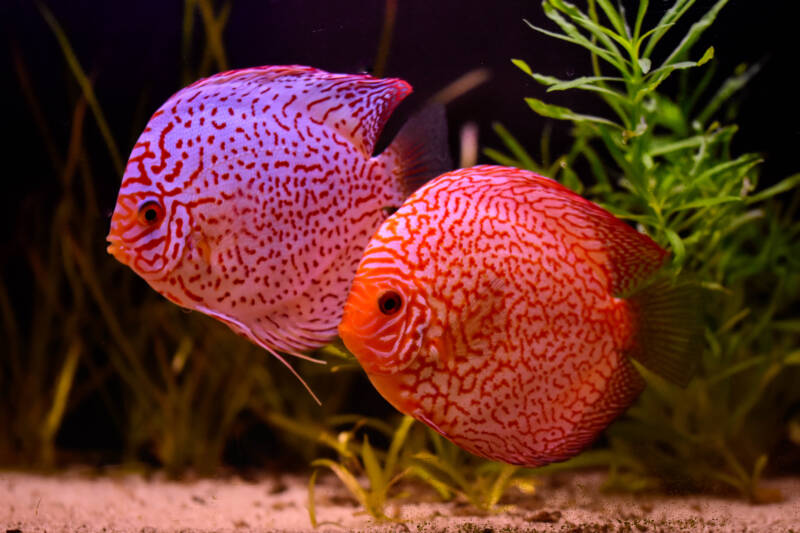
[toc]
Types of Water Hardness
There are two types of water hardness. In the aquarium hobby, the level of calcium and magnesium is called “general hardness” or GH for short.
Many water supplies have medium to high levels of water hardness minerals. The calcium and magnesium cause those white spots on your drinking glasses, shower door, and the aquarium glass.
General hardness does not have an effect on pH.
Alkalinity, or the level of carbonate and bicarbonate in the water, is known as “carbonate hardness” or KH in the aquarium hobby.
Alkalinity has a direct connection to the pH in your aquarium. Here’s why.
Alkalinity and pH
Alkalinity acts as a pH buffer. This means it neutralizes any attempt to raise or lower the pH of the water.
If your tap water has a medium to high alkalinity, it will probably have a pH of at least 7.8. It could be as high as 9.0!
As you can see, using water with high alkalinity in your aquarium will cause the pH to be high.
It will also be very difficult to lower the pH because the alkalinity will fight against the pH adjusters you add to the tank.
You will first have to lower the alkalinity level to make a significant, lasting pH adjustment. We’ll explain how to do that later in the article.
Testing Water Hardness and Alkalinity
While general hardness does not play a role in the pH, it is a good idea to know what the GH level is, especially if you want to keep soft water Amazonian fish and plants.
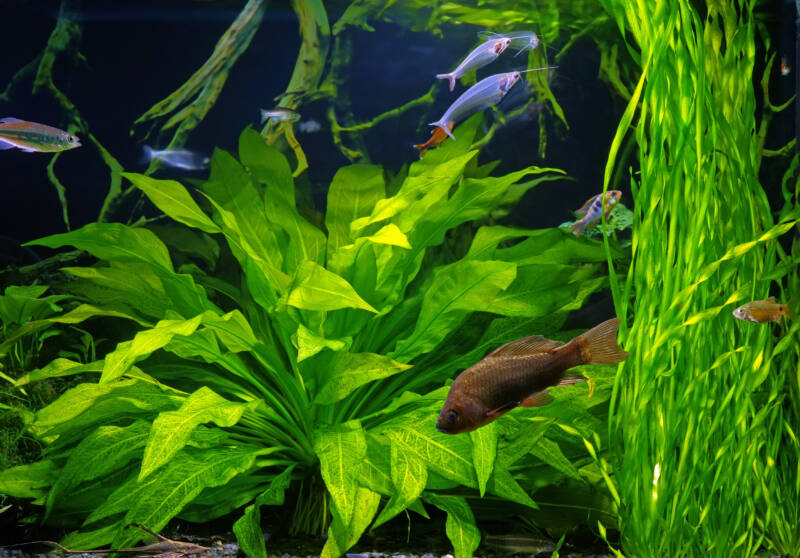
But your main focus is going to be on carbonate hardness. It is essential to get an idea of the KH level when you want to lower the pH.
Liquid KH hardness test kits are easy to use and will provide very accurate results. You can use dip strips to get a general idea, but results won’t be as precise as with liquid test kits.
Why pH Adjusters Don’t Work
pH adjusters can work, but most aquarists have trouble using them to lower the pH in their aquariums. Here’s an example to explain why.
Your tank has an alkalinity level of 250 ppm and a pH of 8.0. You treat the water with a pH-lowering product.
The pH temporarily dips but rises within 24 hours. You add another dose with the same results. Then, you add a third and fourth dose, and results are the same. Why?
Every dose of pH adjuster reacts with the alkalinity and is neutralized. If you monitor the alkalinity level, you will see it drop by a few PPM every time you treat the aquarium water with a pH-down product.
But there is still plenty of alkalinity in the water to keep the pH high and neutralize many doses of pH adjuster.
Even if you did eventually lower the KH level, once you top off the tank with tap water, the KH is right back where you started! pH won’t drop until the alkalinity is reduced.
How to Lower Alkalinity
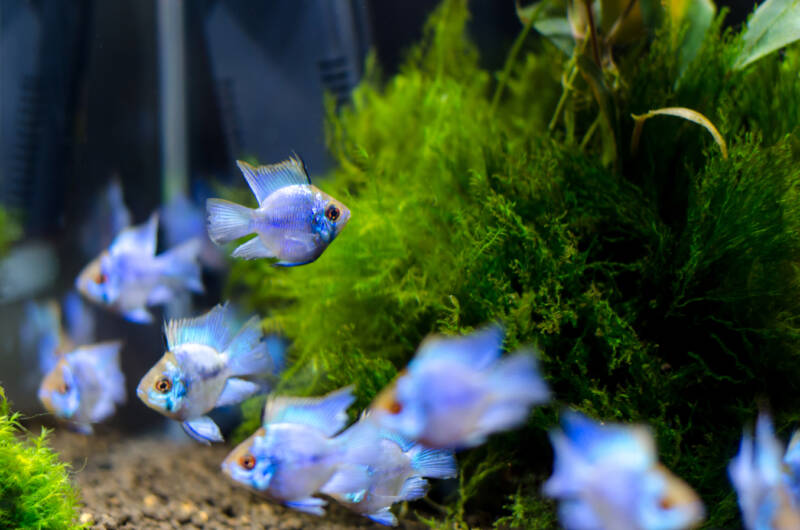
There are several ways to reduce alkalinity and make it easier to lower the pH in your aquarium.
Reverse Osmosis
Aquarists who are serious about keeping live plants and fish that thrive in soft acidic water often have a reverse osmosis (RO) filter to purify their tap water.
The low alkalinity makes it easy to adjust the pH. Topping with RO prevents the alkalinity from creeping back up.
Distilled Water
If you have a small aquarium and don’t need a lot of purified RO water, you can buy a couple of gallons of distilled water.
Blend the distilled water with tap water, just like RO water. Top off with distilled water.
Peat Moss
You may have heard about using peat moss to lower the pH. Here’s how it works.
Sphagnum peat moss has a pH of 3.0-4.0. The moss contains sulfur compounds. The sulfur forms sulfuric acid in water.
When peat moss is placed in aquarium water, the acid in the moss is exchanged for calcium and magnesium, lowering the GH and making the water soft.
The acid then neutralizes some of the carbonate hardness, lowering the pH. Peat moss softens the water and releases acids that neutralize some of the KH.
Tips For Using Peat Moss
- Use only natural peat with no additives.
- Many aquarists prefer Canadian peat moss.
- You’ll need a filter bag to contain the moss.
- Hang the bag in the tank or place it inside a power filter.
How Much is Peat Moss Needed?
That’s a tough question. It depends on the volume of aquarium water and KH level.
It’s a good idea to use a small amount and see how it works in your tank. Use more if the pH and KH do not drop in a few days.
You can also experiment in a bucket of water instead of your tank. You’ll be able to develop a custom dose of peat moss per gallon of aquarium water.
Indian Almond Leaves
Plant leaves, including almond leaves, contain organic compounds called tannins.
As the leaves decay, tannic acid is released. Tannic acid is considered a “weak” acid. It will neutralize some KH over several days.
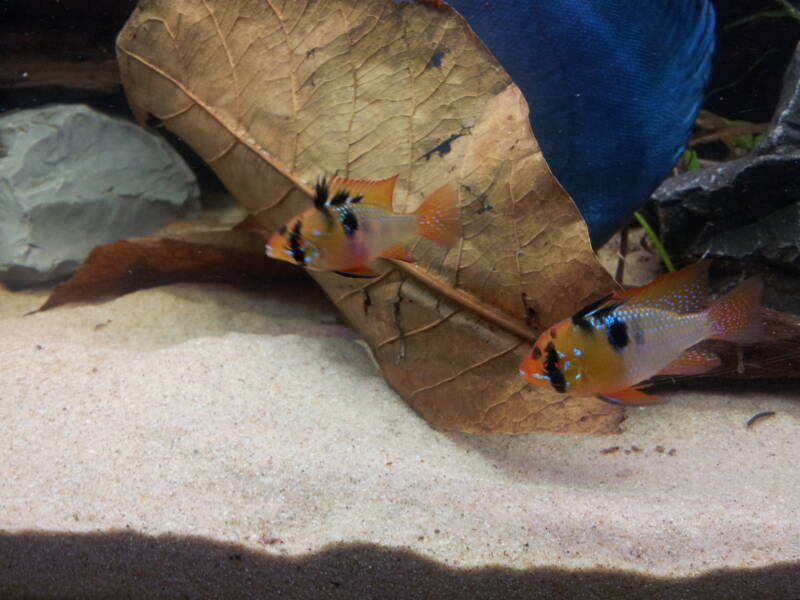
Allowing almond leaves to decay in high-alkalinity water probably won’t help to lower pH.
Aquarists with tiny tanks with low alkalinity water have good results when they scatter a layer of leaves on the bottom of the aquarium.
Driftwood
Driftwood sometimes releases acidic tannins, but it all depends on the type and amount of wood placed in the tank. Unless a lot of wood is added, you may not see much pH change.
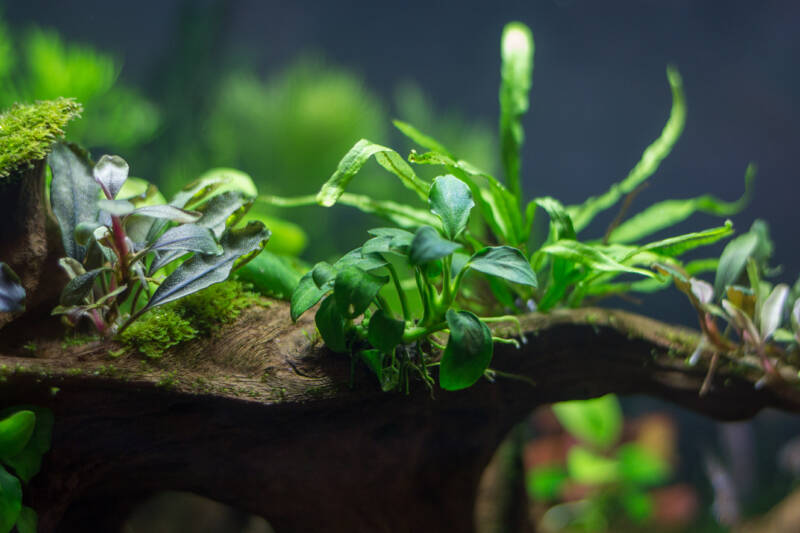
Driftwood is not the most reliable way to lower alkalinity and pH in an aquarium.
Vinegar
Vinegar is a “weak” organic acid. Aquarists have tried to use it to lower pH with mixed results.
Even though it is considered “natural,” you’re still adding a chemical (acetic acid) acid to lower the pH.
The problem with vinegar is that certain types of bacteria living in the aquarium will feast on it, triggering a massive bacterial bloom. This makes the water cloudy and may cause a drop in oxygen level.
Chemical pH Adjusters
pH lowering liquids are made from “strong” acids such as sulfuric and phosphoric acid. Strong acids release more acidic hydrogen ions than weak acids.
For aquarium use, they’re diluted for easy dosing and handling. Each dose neutralizes some of the KH.
Once the KH is reduced to 100 ppm or less, the pH will begin to drop and stay lower in between periodic maintenance doses.
pH Buffers
Buffers are different than simple acids. Buffers are formulated to create a specific pH in your tank. A pH 7 buffer will automatically raise or lower the pH to keep it in the 7.0 range.
The buffer is designed to overpower the existing carbonate hardness and drive the pH down, even if the KH is relatively high.
Stabilizing the pH
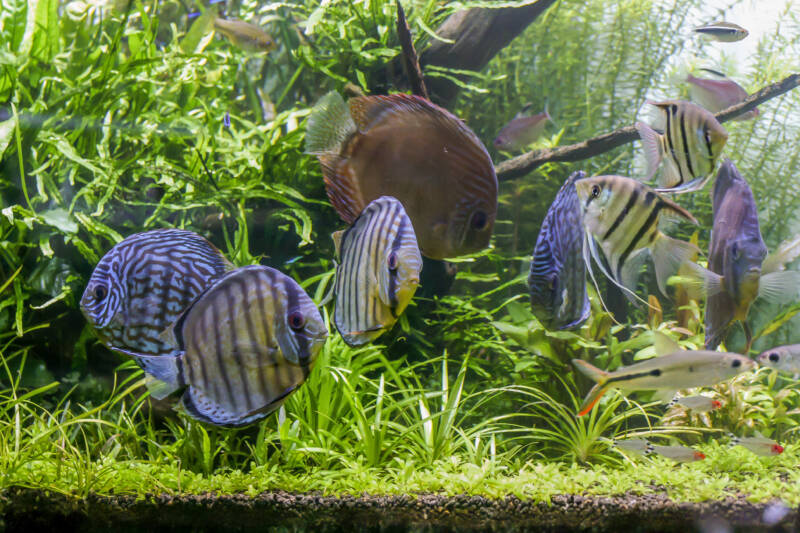
Once the KH in the aquarium is around 50-100 ppm, several things happen to stabilize the pH in the neutral to acidic pH range.
Carbon dioxide that diffuses into the water from the air will slightly acidify the water. CO2 from fish respiration also works to keep the pH from bouncing back up to the high range.
CO2 plays an important role in keeping the pH in the neutral to acidic range in low KH water.
You’ll need less pH lowering additives because with lower alkalinity the pH is easy to adjust.
Monitoring pH and Alkalinity
When keeping a soft, acidic aquarium, you’ll need to monitor the pH and alkalinity every few weeks. This type of tank can develop a very low pH if the alkalinity is permitted to drop too low.
- Monitor pH with a test kit or pH meter calibrated for pH 7.0 or below.
- Test KH and add tap water to increase alkalinity if the pH and KH drop below 50 ppm.
- Learn what level of KH keeps the pH where you want it to be.
Final Thoughts
High carbonate hardness prevents the pH from being easily lowered. Use one of the methods described in this article to lower the KH.
Once the KH is brought down to about 100 ppm, lowering the pH will be much easier. Avoid adding high-KH tap water back to the tank since it will increase the pH.
If you have questions or comments, please leave them below.
